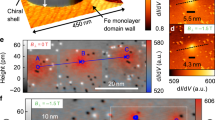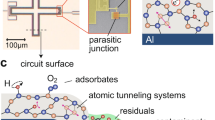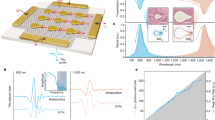Abstract
Electronic defect states at material interfaces provide highly deleterious sources of noise in solid-state nanostructures, and even a single trapped charge can qualitatively alter the properties of short one-dimensional nanowire field-effect transistors (FET) and quantum bit (qubit) devices1,2,3,4,5. Understanding the dynamics of trapped charge is thus essential for future nanotechnologies, but their direct detection and manipulation is rather challenging2,4,5. Here, a transistor-based set-up is used to create and probe individual electronic defect states that can be coherently driven with microwave (MW) pulses. Strikingly, we resolve a large number of very high quality (Q ∼ 1 × 105) resonances in the transistor current as a function of MW frequency and demonstrate both long decoherence times (∼1 μs—40 μs) and coherent control of the defect-induced dynamics. Efficiently characterizing over 800 individually addressable resonances across two separate defect-hosting materials, we propose that their properties are consistent with weakly driven two-level systems.
This is a preview of subscription content, access via your institution
Access options
Subscribe to this journal
Receive 12 print issues and online access
$259.00 per year
only $21.58 per issue
Buy this article
- Purchase on Springer Link
- Instant access to full article PDF
Prices may be subject to local taxes which are calculated during checkout




Similar content being viewed by others
Change history
30 June 2017
In this work we reported the development of a rigorous mathematical and physical framework in order to model the detailed time-resolved behaviour of over 800 resonances that we studied, through continuous-wave and single-pulse microwave spectroscopy measurements in a field-effect transistor. It has been pointed out to us that we omitted citations to the following works, which report continuous-wave measurements of high-Q resonances in similar devices: T. Ferrus et al., J. Appl. Phys. 106, 033705 (2009); A. Rossi & D. G. Hasko, J. Appl. Phys. 108, 034509 (2010); M. Erfani, D. G. Hasko, A. Rossi, W. S. Cho & J.-B. Choi, Appl. Phys. Lett. 99, 192108 (2011). The observations were assigned by the authors to spatial Rabi oscillations of trapped electrons. In our work, the experimental evidence that is currently available cannot unambiguously assign the microscopic origin of the observed resonances (see conclusions).
References
Salfi, J., Savelyev, I. G., Blumin, M., Nair, S. V. & Ruda, H. E. Direct observation of single-charge-detection capability of nanowire field-effect transistors. Nat. Nanotech. 5, 737–741 (2010).
Palomaki, T. A. et al. Multilevel spectroscopy of two-level systems coupled to a dc SQUID phase qubit. Phys. Rev. B 81, 144503 (2010).
Svensson, S. F. et al. Using polymer electrolyte gates to set-and-freeze threshold voltage and local potential in nanowire-based devices and thermoelectrics. Adv. Funct. Mater. 25, 255–262 (2015).
Grabovskij, G. J., Peichl, T., Lisenfeld, J., Weiss, G. & Ustinov, A. V. Strain tuning of individual atomic tunneling systems detected by a superconducting qubit. Science 338, 232–234 (2012).
Lisenfeld, J. et al. Decoherence spectroscopy with individual two-level tunneling defects. Sci. Rep. 6, 23786 (2016).
Mueller, H. H. & Schulz, M. Random telegraph signal: an atomic probe of the local current in field-effect transistors. J. Appl. Phys. 83, 1734–1741 (1998).
Forbes, L. & Miller, D. A. A percolation model for random telegraph signals in metal-oxide-silicon field effect transistor drain current. Appl. Phys. Lett. 93, 043517 (2008).
Salfi, J., Nair, S. V., Savelyev, I. G., Blumin, M. & Ruda, H. E. Evidence for nonlinear screening and enhancement of scattering by a single Coulomb impurity for dielectrically confined electrons in InAs nanowires. Phys. Rev. B 85, 235316 (2012).
Zhang, Y. et al. Charge percolation pathways guided by defects in quantum dot solids. Nano Lett. 15, 3249–3253 (2015).
Tabe, M. et al. Single-electron transport through single dopants in a dopant-rich environment. Phys. Rev. Lett. 105, 016803 (2010).
Tabe, M., Udhiarto, A., Moraru, D. & Mizuno, T. Single-photon detection by Si single-electron FETs. Phys. Status Solidi A 208, 646–651 (2011).
Kohler, S., Lehmann, J. & Hänggi, P. Driven quantum transport on the nanoscale. Phys. Rep. 406, 379–443 (2005).
Ovadyahu, Z. Microwave-enhanced hopping conductivity: a non-ohmic effect. Phys. Rev. B 84, 165209 (2011).
Luk’yanchuk, B. et al. The Fano resonance in plasmonic nanostructures and metamaterials. Nat. Mater. 9, 707–715 (2010).
Anderson, P. W., Halperin, B. I. & Varma, C. M. Anomalous low-temperature thermal properties of glasses and spin glasses. Philos. Mag. 25, 1–9 (1972).
Paladino, E., Galperin, Y. M., Falci, G. & Altshuler, B. L. 1/f noise: implications for solid-state quantum information. Rev. Mod. Phys. 86, 361–418 (2014).
Hollenberg, L. C. L. et al. Charge-based quantum computing using single donors in semiconductors. Phys. Rev. B 69, 113301 (2004).
Shi, Z. et al. Fast coherent manipulation of three-electron states in a double quantum dot. Nat. Commun. 5, 3020 (2014).
Urdampilleta, M. et al. Charge dynamics and spin blockade in a hybrid double quantum dot in silicon. Phys. Rev. X 5, 031024 (2015).
Neeley, M. et al. Process tomography of quantum memory in a Josephson-phase qubit coupled to a two-level state. Nat. Phys. 4, 523–526 (2008).
Lisenfeld, J. et al. Observation of directly interacting coherent two-level systems in an amorphous material. Nat. Commun. 6, 6182 (2015).
Scully, M. O. & Zubairy, M. S. Quantum Optics (Cambridge Univ. Press, 1997).
Pla, J. J. et al. High-fidelity readout and control of a nuclear spin qubit in silicon. Nature 496, 334–338 (2013).
Burnett, J. et al. Evidence for interacting two-level systems from the 1/f noise of a superconducting resonator. Nat. Commun. 5, 4119 (2014).
Martinis, J. M. et al. Decoherence in Josephson qubits from dielectric loss. Phys. Rev. Lett. 95, 210503 (2005).
Wolfowicz, G. et al. Atomic clock transitions in silicon-based spin qubits. Nat. Nanotech. 8, 561–564 (2013).
Faoro, L. & Ioffe, L. B. Quantum two level systems and Kondo-like traps as possible sources of decoherence in superconducting qubits. Phys. Rev. Lett. 96, 047001 (2006).
Thorbeck, T. & Zimmerman, N. M. Formation of strain-induced quantum dots in gated semiconductor nanostructures. AIP Adv. 5, 087107 (2015).
Shalibo, Y. et al. Lifetime and coherence of two-level defects in a Josephson junction. Phys. Rev. Lett. 105, 177001 (2010).
Neeley, M. et al. Process tomography of quantum memory in a Josephson-phase qubit coupled to a two-level state. Nat. Phys. 4, 523–526 (2008).
Acknowledgements
J.O.T.-P. would like to acknowledge financial support from the Cambridge Overseas Trust and the Mexican National Council on Science and Technology (CONACyT). E.D.H. would like to acknowledge financial support from the Japan Society for the Promotion of Science (JSPS). S.F. would like to acknowledge financial support from the Engineering and Physical Sciences Research Council (EPSRC). A.W.C. acknowledges support from the Winton Programme for the Physics of Sustainability. We would like to thank A. Nunnenkamp (University of Cambridge, UK) and H. Baranger (Duke University) for useful discussions.
Author information
Authors and Affiliations
Contributions
J.O.T.-P., S.F. and E.D.H. performed and designed the experiments, prepared the samples and performed data processing and analysis. C.C. and A.W.C. performed theoretical modelling. J.O.T.-P., E.D.H., C.C. and A.W.C. performed the numerical simulations. J.O.T.-P., C.C. and A.W.C. conceived the work and wrote the manuscript in consultation with S.O. and W.I.M., and all authors commented on the manuscript.
Corresponding authors
Ethics declarations
Competing interests
The authors declare no competing financial interests.
Supplementary information
Supplementary Information
Supplementary Information (PDF 2047 kb)
Rights and permissions
About this article
Cite this article
Tenorio-Pearl, J., Herbschleb, E., Fleming, S. et al. Observation and coherent control of interface-induced electronic resonances in a field-effect transistor. Nature Mater 16, 208–213 (2017). https://doi.org/10.1038/nmat4754
Received:
Accepted:
Published:
Issue Date:
DOI: https://doi.org/10.1038/nmat4754
This article is cited by
-
Suppression of low-frequency charge noise in superconducting resonators by surface spin desorption
Nature Communications (2018)
-
Correction: Corrigendum: Observation and coherent control of interface-induced electronic resonances in a field-effect transistor
Nature Materials (2017)
-
High-accuracy current generation in the nanoampere regime from a silicon single-trap electron pump
Scientific Reports (2017)



